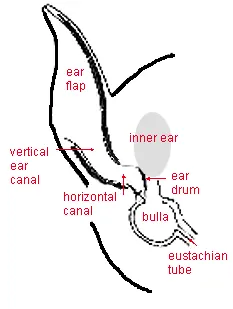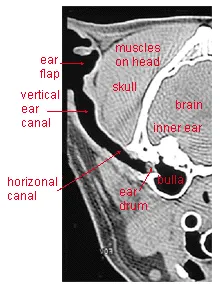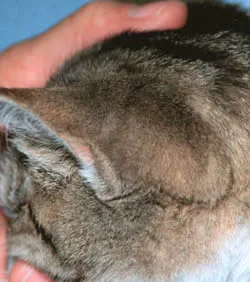Most cats resist ear exams, cleaning, or treatments, but with patience and the right technique, you can handle cat ear cleaning and medicating at home effectively. This guide provides step-by-step instructions to help cat owners manage common ear issues like infections or mites, ensuring your feline friend’s comfort and health. Whether dealing with redness, discharge, or head shaking, proper cat ear care prevents complications and promotes well-being.
Understanding your cat’s ear structure is crucial before starting. The ear has three main parts: the outer ear, middle ear, and inner ear. Cats’ L-shaped ear canals differ from humans’, making cleaning trickier and increasing rupture risks if done improperly.
 Simple drawing of cat
Simple drawing of cat Radiograph of skull labeled.
Radiograph of skull labeled.
The outer ear includes the pinna (ear flap), which funnels sound into the narrow canal bending at nearly 90 degrees. This canal leads to the eardrum separating it from the middle ear, which houses small bones, the bulla, and the eustachian tube. The inner ear links to the brain for balance and hearing.
 Photo of back of a cat
Photo of back of a cat
A healthy outer ear flap is fur-covered, but itching from ear mites or infections can cause hair loss or scratches at the base. Severe cases may tear the edges. Inside, expect a pink hue with minimal black discharge; heavy black wax signals mites.
 Photo of what is described in the following paragraph.
Photo of what is described in the following paragraph. Photo of what is described in the following paragraph.
Photo of what is described in the following paragraph.
For related skin concerns from excessive scratching, check out our guide on cat flaky skin.
Signs of Ear Infections in Cats
Watch for these common symptoms of ear infections: redness, foul-smelling discharge, odor, head shaking, scratching, or rubbing ears on surfaces. Early detection prevents deeper issues like middle or inner ear involvement, which may require veterinary intervention.
Prompt care supports overall skin and coat health—consider best skin and coat supplement for cats for holistic support.
Restraining Your Cat for Ear Care
Prepare by wearing protective clothing and using an easy-to-clean surface, as cat ear cleaning can get messy. For cooperative cats, lap or table work suffices; others need restraint.
 Photo of what is described in the following paragraph.
Photo of what is described in the following paragraph.
Position your cat in your lap, draping your left forearm across its body. Use your left thumb to press the ear flap back, opening the canal. Hold medication or cleaner in your right hand. This secure hold minimizes stress and ensures safety.
Step-by-Step Guide to Cleaning Cat Ears
Consult your vet for the best ear cleaning solution, as some contain drying agents and overuse can harm the ear. Frequency depends on the product and condition.
Apply drops to the ear flap first, then insert the bottle tip just millimeters into the canal—marked by a yellow X in diagrams—to deposit solution without forcing.
 Photo of what is described in the following paragraph.
Photo of what is described in the following paragraph.
Your cat will likely shake its head, expelling excess. Gently massage the ear base to mix the solution throughout the canal—many cats enjoy this.
 Photo of what is described in the following paragraph.
Photo of what is described in the following paragraph. Photo of what is described in the following paragraph.
Photo of what is described in the following paragraph.
Wipe visible discharge from the flap with cotton balls. For precision, use cotton swabs on the visible inner flap only—never deeper, to avoid eardrum rupture or debris impaction.
 Photo of what is described in the following paragraph.
Photo of what is described in the following paragraph.
Administering Ear Medications to Cats
Clean ears first for optimal medication efficacy, whether ointments or drops. Your vet may instruct pre-cleaning or recommend sedation for exams if foreign bodies like plant material are suspected or samples are needed.
Place a dab on the flap and drops into the canal, inserting the applicator shallowly. Stretch the ear to straighten the bend for full coverage—avoid deep insertion to protect the eardrum.
 Photo of what is described in the following paragraph.
Photo of what is described in the following paragraph.
Massage the base post-application to distribute.
 Photo of what is described in the following paragraph.
Photo of what is described in the following paragraph.
Severe cases might need oral meds or surgery for middle ear infections. For tick prevention that supports ear health, explore cat tick medicine.
In summary, mastering cat ear cleaning and medicating at home builds confidence in pet care routines. Always prioritize vet guidance for tailored advice, especially with persistent symptoms. Regular checks catch issues early, keeping your cat happy and healthy—share your experiences in the comments or explore more tips like natural remedies for cat digestion.
References
- Washington State University College of Veterinary Medicine: Ear Medication Instructions.
- Consult licensed veterinarians for personalized care; this is not a substitute for professional advice.
